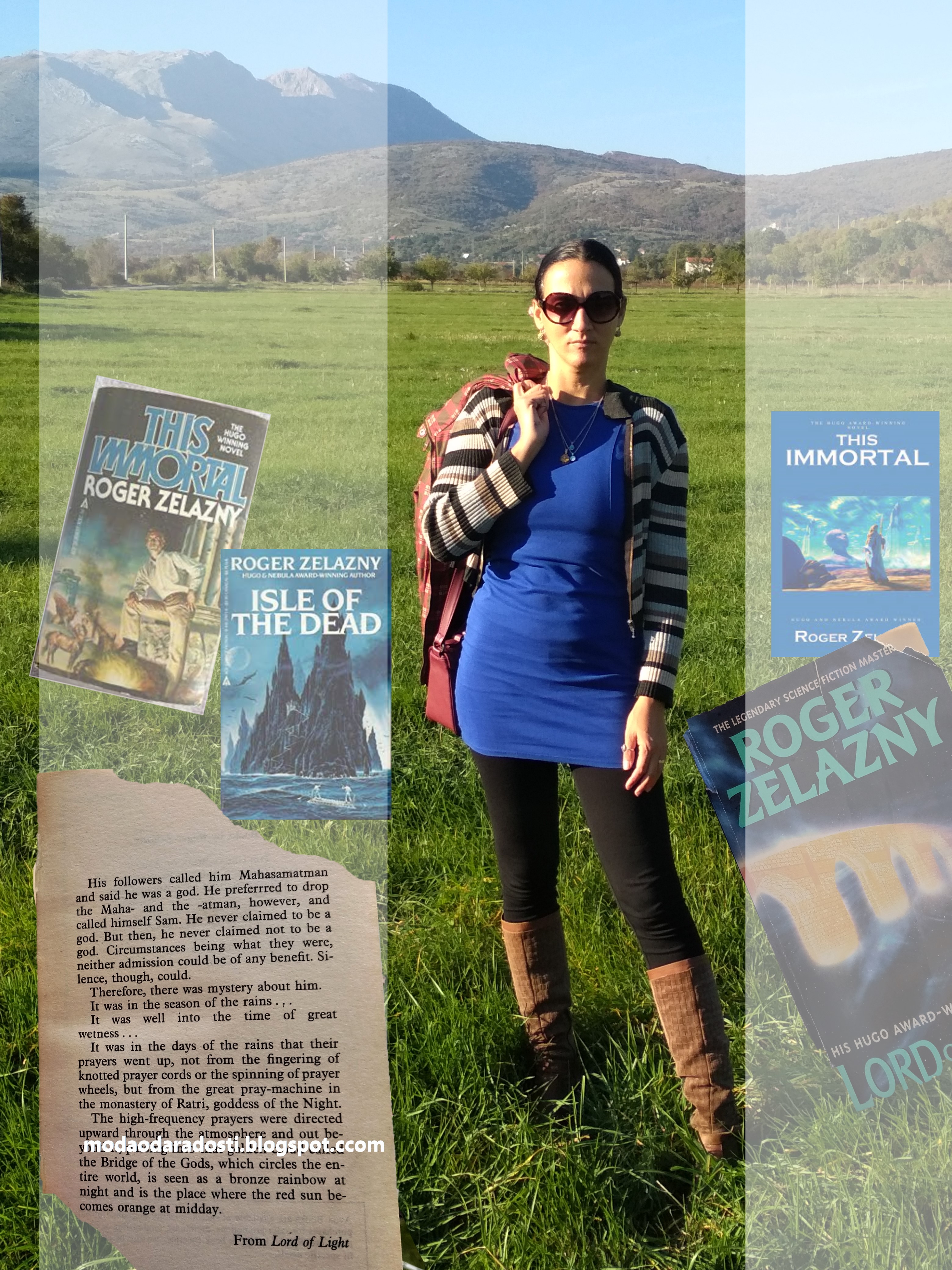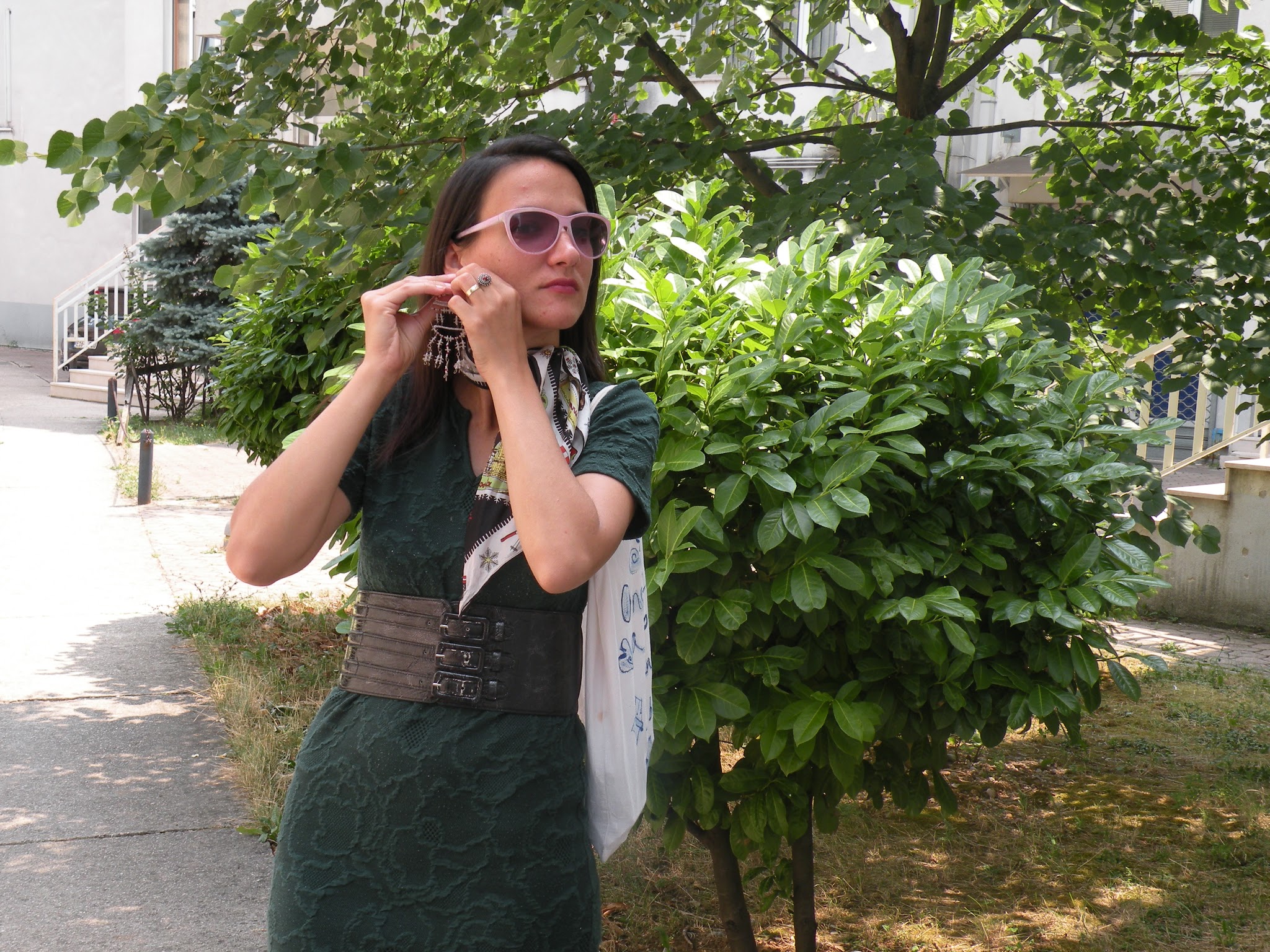THE ISLE OF THE DEAD, A NOVEL BY ROGER ZELAZNY
Today I'm going to review The Isle of the Dead , a science fiction novel by Roger Zelazny. Published in 1969, it was nominated for Nebula award for the best novel. While The Isle of the Dead didn't win the Nebula award that year, it did win the French Prix Apollo in 1972. I'm happy I finally got around to reading The Isle of the Dead, as it didn't disappoint. It is one of those science fiction novels that are worth the hype. I immensely enjoyed reading it and would recommend it (especially to the fans of this genre and writer).
If the title of this novel made you think of a certain painting, you're making the right connection in your head. The title of the novel is a reference to a famous painting (or better to say a series of paintings) by Swiss German painter Arnold Böcklin. A certain place in the novel was clearly inspired by the above mentioned painting. Moreover, the novel's protagonist Francis mentions the painting as 'that mad painting by Boecklin.' Not only does the novel itself reference the painting but it was published with art directly inspired by Arnold's work. For me personally, the two (the painting and the novel) are interwoven in my mind. This is even more the case now that I have finally read the novel. I will always think of this novel while looking at this painting and vice versa. I'll publish this post accompanied by some of my own art because somehow it feels appropriate.
This science fiction novel was on my reading list for a long time. As some of you might know, I'm somewhat of a Zelazny fan. I started to read his works back in high-school. I've always loved his poetic style of writing and larger than life protagonists. Not surprisingly, quotes from this writer have appeared on my blog quite often. You may check out those posts if you want:
- A BOOK REVIEW AND RECOMMENDATION: THIS IMMORTAL BY ROGER ZELAZNY
- READING UPDATE : R. ZELAZNY
- BOOK OF THE DAY (LORD OF LIGHT, A NOVEL BY ROGER ZELAZNY)
- A NIGHT IN LONESOME OCTOBER, A NOVEL BY ROGER ZELAZNY
THE AUTHOR - ROGER JOSEPH ZELAZNY (1935- 1995)
Who was Roger Zelazny? Born in United States of America (a son of a Polish immigrant Joseph and Irish-American Josephine), Roger Zelazny was an writer of science fiction and fantasy, mostly known for his science fiction/fantasy short stories and novels. Roger Zelazny also wrote some poetry and this influenced his prose works. Indeed, Zelazny was known to adapt lyrical style of writing. I remember reading somewhere how he (at some point in his early life), abandoned writing prose, went on to study English ( and write poetry) and then he finally got back to writing prose again.
I'm pretty sure that is how his signature lyrical prose came to be, but to make sure you better consult his interviews for more information (for example here , here and here) or specific publications about his work. Zelazny's work was heavily influenced by his interest in mythology and history. He is perhaps best know for The Chronicles of Amber, a series of ten novels, set in alternative reality. In his novels and shorts stories, Zelazny often mixed elements of fantasy and science fiction, sometimes bridging the gap between the two. During his long career, he won many awards, including 3 Nebula Awards and 6 Hugo Awards. He was nominated 14 times for the Nebula and Hugo Award.
THE PLOT INTRODUCTION (CITED FROM WIKIPEDIA): Francis Sandow is the last surviving human born in the 20th century. An early space colonist, he spent long centuries of space travel in suspended animation. After his last such trip, he woke in the 27th century, where everything had changed. Desperate for something to hold to, he sought out a mentor, who happened to be a member of a very long-lived and slowly dying alien race, the Pei'ans. Under this tutelage, Sandow eventually became a telepath and "worldscaper". Worldscapers have the ability to create and/or terraform planets. The process of becoming a worldscaper culminates in a mystic rite called "Naming" that binds the mortal to one of the gods in the Pei'an pantheon, and it is believed that the worldscaper is actually acting as an avatar for the god. There are only twenty-seven existing worldscapers; Sandow, bound to Shimbo of Darktree, Shrugger of Thunders, is the only non-Pei'an among them. Outworlders are welcome to practice the religion, which is called Strantri. Sandow opines it will be the first major religion to outlive its founders. Unlike most of the Pei'an deities, who tend to be chimeras like Egyptian gods, Shimbo is also unmistakably human, showing that the Pei'ans had visited Earth in the distant past. The rite of Naming was once reserved for the high priests of the Pei'an religion. Sandow is a confirmed agnostic as far as the objective existence of the gods is concerned. However, whenever he sits for a time in a Strantri shrine, the icon of Shimbo always lights up, and this happens simultaneously in every shrine in the galaxy. At the beginning of the novel, Sandow is one of the most famous men in the Galaxy, wealthy beyond imagination, living a life of seclusion and luxury in worlds he fashions according to his taste. But he is lured into action by a series of photographs sent to him anonymously, showing him old enemies, old friends, and old lovers—most of whom should be dead, but appearing in the photographs to be alive.
THE FIRST PERSON NARRATION BY THE LARGER OF LIFE PROTAGONIST
The novel is narrated by Frank (Francis), a larger than life character that is slightly sarcastic and self-depreciating. As a protagonist, Francis felt very familiar. In fact, Zelazny often wrote this kind of character as the book's lead.
THE NARRATOR (WRITER) OFTEN GETS PHILOSOPHICAL
The protagonist of this novel often gets philosophical. He's a rather old guy (albeit in good shape). The concept of the novel is that he is the oldest person living.
Life is a thing--if you'll excuse a quick dab of philosophy before you know what kind of picture I'm painting--that reminds me quite a bit of the beaches around Tokyo Bay. Now, it's been centuries since I've seen that Bay and those beaches, so I could be off a bit. But I'm told that it hasn't changed much, except for the condoms, from the way that I remember it. I remember a terrible expanse of dirty water, brighter and perhaps cleaner way off in the distance, but smelling and slopping and chill close at hand, like Time when it wears away objects, delivers them, removes them. Tokyo Bay, on any given day, is likely to wash anything ashore. You name it, and it spits it up some time or other: a dead man, a shell that might be alabaster, rose and pumpkin bright, with a sinistral whorling, rising inevitably to the tip of a horn as innocent as the unicorn's, a bottle with or without a note which you may or may not be able to read, a human foetus, a piece of very smooth wood with a nail hole in it--maybe a piece of the True Cross, I don't know--and white pebbles and dark pebbles, fishes, empty dories, yards of cable, coral, seaweed, and those are pearls that were his eyes. Like that. You leave the thing alone, and after awhile it takes it away again. That's how it operates.
LIFE IS LIKE A TOKYO BAY: ANYTHING GOES
There's one passage at the beginning of the novel that I quite like and that I'm going to share. I think it captures well the 'anything goes' philosophy that takes a rather tolerant view on things.
Sometimes, as I'd walk along the beach in the sun-spanked morning, the chill breezes helping me to recover from the effects of rest and recuperation leave from a small and neatly contained war in Asia that had cost me a kid brother, sometimes then I would hear the shrieking of birds when there were no birds in sight. This added the element of mystery that made the comparison inevitable: life is a thing that reminds me quite a bit of the beaches around Tokyo Bay. Anything goes. Strange and unique things are being washed up all the time. I'm one of them and so are you. We spend some time on the beach, maybe side by side, and then that slopping, smelling, chilly thing rakes it with the liquid fingers of a crumbling hand and some of the things are gone again. The mysterious bird-cries are the open end of the human condition. The voices of the gods? Maybe. Finally, to nail all corners of the comparison to the wall before we leave the room, there are two things that caused me to put it there in the first place: sometimes, I suppose, things that are taken away might, by some capricious current, be returned to the beach. I'd never seen it happen before, but maybe I hadn't waited around long enough. Also, you know, somebody could come along and pick up something he'd found there and take it away from the Bay.
ALWAYS READY TO HELP THE DAMSEL IN DISTRESS BUT DON'T EXPECT TOO MUCH FROM THE FEMALE CHARACTERS
The third one said, in English: "I do not want it to seem as if I am trying to presume on something long gone by, but I am in serious trouble and you are the only person I can think of who might be able to help me. If you can possibly make it in the near future, please come see me on Aldebaran V. I'm still at the old address, although the place has changed quite a bit. Sincerely, Ruth." Three appeals to the humanity of Francis Sandow. Which, if any of them, had anything to do with the pictures in my pocket? The orgy I had called short had been a sort of going-away party. By now, all of my guests were on their ways off my world. When I had started it as an efficient means of getting them loaded and shipped away, I had known where _I_ was going. The arrival of Kathy's picture, though, was making me think. All three parties involved in the correspondence knew who Kathy had been. Ruth might once have had access to a picture of her, from which some talented person might work. Marling could have created the thing. Central Intelligence could have dug up old documents and had it forged in their labs. Or none of these. It was strange that there was no accompanying message, if somebody wanted something. I had to honor Marling's request, or I'd never be able to live with myself. That had been first on my agenda, but now-- I had through the fifth season, northern hemisphere, Megapei--which was still over a year away. So I could afford some other stops in between. Which ones would they be? Central Intelligence had no real claim on my services and Earth no dominion over me. While I was willing to help Earth if I could, the issue couldn't be so terribly vital if it had been around for the full twenty years they'd been pestering me. After all, the planet was still in existence, and according to the best information I had on the matter, was functioning as normally and poorly as usual. And for that matter, if I was as important to them as they made out in all their letters, _they_ could have come and seen me. But Ruth-Ruth was another matter. We had lived together for almost a year before we'd realized we were cutting each other to ribbons and it just wasn't going to work out. We parted as friends, remained friends. She meant something to me. I was surprised she was still alive after all this time. But if she needed my help, it was hers. So that was it. I'd go see Ruth, quickly, and try to bail her out of whatever jam she was in.
P.S. I might add more to this review when I find the time! Take care and have a lovely day!








.jpg)










I love your artwork! This sounds like one I want to read by Zelazny, because I love theology and philosophy. I have to get to reading this fascinating novel. Thanks so much for sharing. I hope you have a joyous holiday season dear.
ReplyDeleteMadison xo
FASHION TALES
❤️
DeleteGracias por la reseña, parece interesante. Lo tendré en cuenta. Lindas pinturas , te mando un beso.
ReplyDelete❤️
DeleteI've been looking for Zelazny in the thrift store book sections! This sounds good. So many of the older sci fi writers were all white men who wrote about more white men. NK Jemisen is my most recent favourite sf writer.
ReplyDeleteLove your paintings, Ivana. You're so talented - your style feels looser in these.
❤️
DeleteIt's so good to see you back, Ivana. Whilst Sci-Fi is more Jon's thing than mine, I love your artwork and your ability to capture the sea! xxx
ReplyDelete❤️
DeleteThanks for your sharing:)
ReplyDeleteSo great to see a post from you. I was wondering it all was well with you. Great to read your review. So nice and green there. Dry to the bone here. And Winter is coming as in a snow storm as I write this. I am sure this book must have inspired your art too. Thanks for probing into this classic sci-fy. Happy December❤️🎄❤️
ReplyDelete❤️
DeleteSo exciting to see your review. I hope you have a chance to give us a life update too. All the best with your adventures and artwork. You are so talented on so many levels.
ReplyDelete❤️
DeleteI was happy to see this post from you, Ivana, as I've been thinking of you, wondering how you were.
ReplyDeleteThank you for another in-depth book review, and it's always a joy to see your stunning artwork! xxx
❤️
DeleteGood to see you again. This sounds like a good read and great photos :-D
ReplyDelete❤️
DeleteIt's so nice to see a post from you again and I am very glad that you are well and getting back into your love of reading! :) I like that blue dress on you too.
ReplyDeleteHope you are having a nice weekend :)
www.awayfromtheblue.blogspot.com.au
❤️
DeleteGood to see you again Dear friend. My daughter and i like science fiction novels alot. Roger zelazny's this book sounds really good. Your paintings look beautiful. Happy December. Greetings.
ReplyDeleteI'm not familiar with this author but this book sounds like a compelling read even though sci-fi isn't exactly my thing. So glad to see you back here Ivana. Missed seeing your art and musings. Hope you have been well and wishing you a cozy and magical holiday season!
ReplyDeleteDear Ivana,
ReplyDeleteat the moment I don't have time to read your book description, I just stopped by to wish you
a wonderful Christmas time
and all the best for 2023, Traude
🍎🕯️🎄🌟🎄🕯️🍎
https://rostrose.blogspot.com/2022/12/costa-ricanische-weihnachtsgrue.html
Lovely post! Your paintings look beautiful :)
ReplyDeleteI wish you a happy holiday.
Abdel | Infinitely Posh.
❤️Thank you so much.
DeleteHappy Holidays! I am glad to see your blog again. That Zelazny's novel seems so interesting. Tokyo bay seems not natural, and it is so real. The night view is really science fiction!
ReplyDeleteakiko
https://kimonosnack.blogspot.com
❤️❤️❤️❤️❤️
Delete